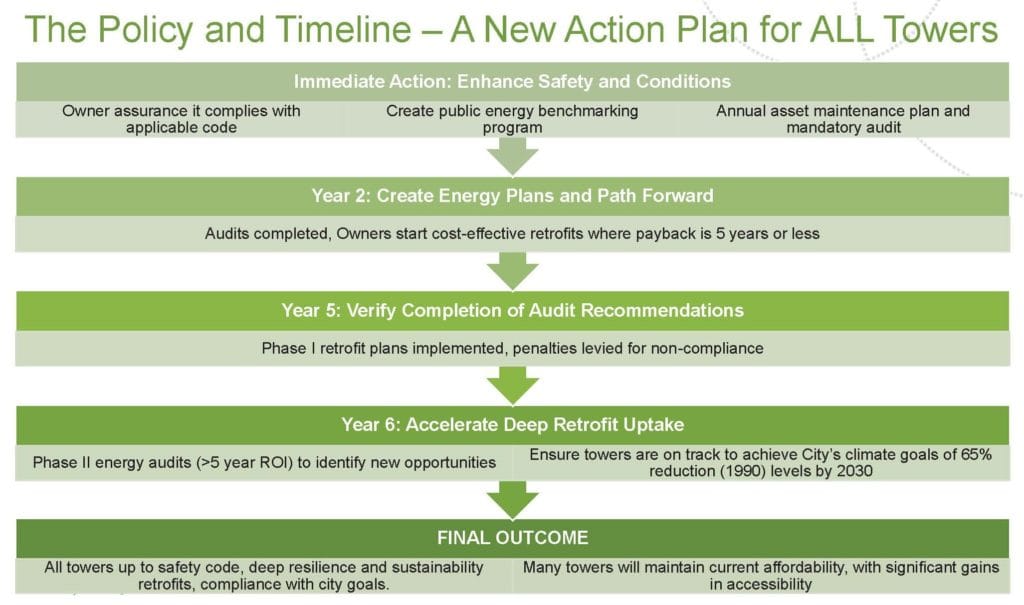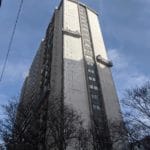Top Story
Location: Toronto, Ontario, Canada
Sponsor: City of Toronto, ULI Toronto, the ULI Foundation
Subject Area: Affordable Housing, Sustainability
Panel Chair: Jim Heid, Founder, Urban Green, LLC – Healdsburg, California
Read February 2021 updates here
Panel Background and Assignment
Aging, purpose-built rental apartment buildings are the backbone of the rental stock in Canada and are home to hundreds of thousands of households with modest and low incomes. Over 500,000 Toronto residents live in approximately 1,000 towers that are 8 or more floors and built before 1985. The majority (85%) of these buildings are privately owned. One in three low-income families live in these apartment towers. With rental rates lower than those of newer rental building, the housing opportunities in Toronto’s Towers provides the “de-facto” affordable housing option for Torontonians.
Yet, these buildings are now over 35 years old and require substantial investment to continue to be safe, comfortable, and healthy places to live for another 50 years – including updated heating systems and windows, back-up power, and possibly central air conditioning. Balancing resilience, affordability, and investment is a public policy objective for all levels of government. Toronto’s Resilience Strategy identified these buildings as an urgent priority for providing the city’s overall resilience, for ensuring affordability is maintained, and for housing lower income populations are adequately. There is enormous opportunity to invest in these buildings to achieve multiple goals, including improving tenant livability, decreasing green-house gas emissions, improving building and community resilience, and increasing workforce development in low-income areas.
While Toronto’s public and non-profit owned towers have made progress on deep retrofits, the goals of continued affordability and expanded investments in retrofits for housing quality and climate resilience do not align in private towers. Innovative solutions will be required to maintain affordable rents. If deep retrofits are possible with a strong return on investment (ROI), these buildings could be one of the last un-tapped real estate opportunities in a tough market.
The focus of the panel was to determine how the public and private sector can work together to unlock the necessary investments and drive sustainable retrofits of Toronto’s towers while maintaining affordability.
Summary of Recommendations

Early observations from the panelists noted that there was extreme stress on the local housing stock, with limited new rental stock being built and tower failures like 650 Parliament just the tip of the iceberg. With that in mind, the panel made the following recommendations for how to renew the towers for safety, comfort, sustainability, and resilience while maintaining affordability:
- Own the towers: The City’s response to the towers should be aligned and focused. Tower renewal currently sits within multiple offices within city government, including but not limited to: Social Development, Finance, and Administration. Because tower renewal requires collaboration across so many different city agencies, the Panel recommended that the Tower issue should be elevated to the City Manager’s office and empowered to direct change.
- Develop Toronto’s long-term housing strategy: The panel strongly affirmed that the towers cannot become Toronto’s de facto affordable housing strategy. As part of a comprehensive plan, the panel emphasized the importance of removing barriers to rental apartment development by making the approval process faster and more predictable as well as considering the development of mid-rise buildings. Panelists also thought that building a robust inclusionary zoning policy tailored to individual neighborhoods with long-term affordability requirements could strengthen affordable options and relieve pressure on the towers.
- Build community resilience: In order to improve livability and the resilience of the tower community, the panel recognized strong opportunities to capitalize on the spaces in between the towers by animated disused spaces. Specifically, the tower recommended the creation of Tower Enhancement Districts (TEDs), connecting local stakeholders and taking the lead in accelerating positive change through aesthetic renewal, social events, small business development, and emergency preparedness. TEDs can also serve as a platform for holistic neighborhood development, assessing local needs and making recommendations when new infill development is considered.
- Balance priorities and accelerate uptake: Panelists identified that it was possible for Toronto to achieve affordability, sustainability, and resilience, but that the public and private sector would have to work together to make it happen. In order to ensure safety and create a path for the future, the panel recommended a set of policies, including owner assurance of building safety, a public energy benchmarking program for transparency and to track progress, and mandatory audits. The panel also highlighted an expanded return on investment (ROI) calculation that considers both owner ROI beyond utility savings and a public sector services ROI. In addition, while there are excellent public and nonprofit retrofit case studies, the panel also suggested a pilot program for 10 private building owners that provides a grant to early adopters, cohort for lessons learned, and creates a roadmaps for how to cost-effectively execute deep retrofits.
